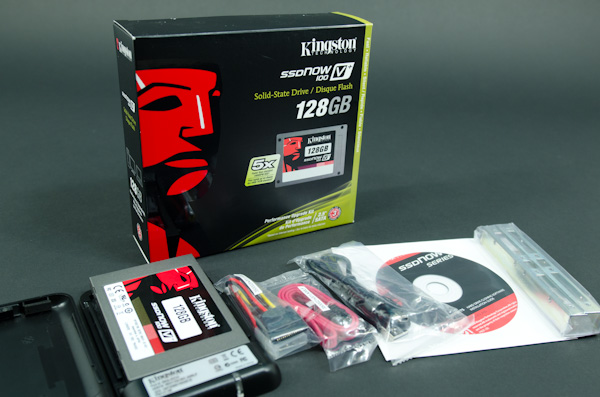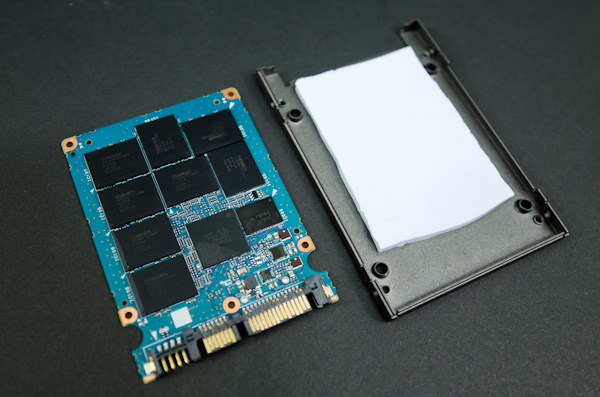Kingston SSDNow V+100 Review
by Anand Lal Shimpi on November 11, 2010 3:05 AM EST- Posted in
- Storage
- SSDs
- Kingston
- SSDNow V+100
Final Words
Kingston, like many of its competitors, desperately needs a simplified product lineup. On the one hand, Kingston has hedged its bets. With three different controller makers supplying hardware for its six SSDs, Kingston can't go wrong. However, the Toshiba powered SSDNow V+ spans the gamut from mediocre random write speed to chart topping performance in some of our workloads. The real world test results are strong enough for me to recommend the drive, however two things don't sit well with me.
First is the price. The V+100 commands a nearly $50 premium over competing SandForce drives. While I can understand paying some premium for Toshiba's name and hopefully reliability, that's a bit much. Compared to the RealSSD C300 the premium is negligible, so the complaint only applies as long as SandForce is in the running.

Kingston sells SSDs as both standalone drives or a part of an upgrade kit
The second issue is the overly aggressive garbage collection. Sequential performance on the V+100 just doesn't change regardless of how much fragmentation you throw at the drive. The drive is quick to clean and keeps performance high as long as it has the free space to do so. This is great for delivering consistent performance, however it doesn't come for free. I am curious to see how the aggressive garbage collection impacts drive lifespan. Kingston ships the V+100 with a 3-year warranty and to Kingston's credit I haven't had any other drives die as a result of wearing out the NAND. Even if the V+100 has higher effective write amplification than the competition, your usage model will determine whether or not you bump into it.
Toshiba is clearly close to knocking this one out of the park. There's a tangible improvement over the original V+ and the drive is clearly doing some things right. The V+100 isn't flawless, but it's finally in the list of drives to consider.
SandForce continues to be the sensible choice, at least in terms of performance per dollar for a boot/application drive. I am careful to mention it as a boot/application drive because if you start storing a lot of incompressible data on the drive (e.g. movies, music, photos) then SandForce quickly loses a lot of its performance advantage. Then you're left with Crucial's RealSSD C300 which delivers more consistent performance regardless of data, at the expense of lower steady state write performance. Without TRIM, the C300 can quickly get into a not-so-great performance situation.
If you don't want a SandForce drive and are running an OS without TRIM support, the V+100 is probably a better option than the C300 thanks to its aggressive garbage collection. I realize this isn't the simplest recommendation, but that's the reality of today's SSD market. There are a lot of great options, but nothing is absolutely perfect.











96 Comments
View All Comments
pvdw - Monday, November 15, 2010 - link
"check the speed without compression and then compare drives "That makes no sense!
It's like saying disable branch predictions on one processor because another doesn't have it. Or disable the turbo on one car when comparing to a competing car that is naturally aspirated.
Out of Box Experience - Monday, November 15, 2010 - link
It makes all the sense because it would be a fair comparison of all the SSD's availableNot all drives have compression and not all data is compressible so why not test them all without compression?
Are you afraid that OCZ would be at the bottom of the list in a fair test like this?
Well, you may be right!
Lets test them to be sure
.harm - Thursday, November 11, 2010 - link
I'm not an expert on SSDs and RAID. So excuse me if my question is a bit stupid.I always understood that it´s impossible to use TRIM with a RAID configuration because the RAID controllers can't ´pass' the TRIM commands. So the SSD performance would drop overtime when using RAID. Now the SSD controller has "always-on garbage collection". Does this mean the performance in a RAID configuration doesn't drop?
AnnihilatorX - Thursday, November 11, 2010 - link
I would think so, it would at least be better off than other drive with less aggressive garbage collection.sparky76 - Thursday, November 11, 2010 - link
Will controllers like this leave OS X with a performance advantage over Windows 7, precisely because OS X has no support for the TRIM command?It seems that Win7 will have some system overhead in running TRIM while any OS without TRIM support will not suffer this, as garbage collection will be left to the firmware in the drive.
DoktorSleepless - Thursday, November 11, 2010 - link
I would love to see loading and minimum frame rate tests from actual games like what was done here a while back.http://www.anandtech.com/show/2614/14
It's just really hard to visualize real world performance even from Vantage.
I would bet a game like Fallout 3 would benefit a lot in the minimum frame rate department since it's always loading new data from the hard drive.
Nickel020 - Thursday, November 11, 2010 - link
I second this. While the IOPS for Bench are a nice measure, I don't know how to actually translate that into real world performance differences. I.e. are the differences in IOPS between say the new Kingston drive and Sandforce drives actually noticeable, and if yes, how noticeable?I would like to see a review that shows how much faster a Sandforce drive is than my old Vertex 1 and X25-M G2.
Chloiber - Thursday, November 11, 2010 - link
I'd also like to see that, as I said before.Just look at this test from (german) CB as an example:
http://translate.google.com/translate?js=n&pre...
Huge differences in synthetic tests, but a normal desktop system is just too slow to actually benefit from this!
I'm also missing these kinds of tests here. I think your earlier tests were better - now you just go through synthetic tests and show us the results, this isn't the thing I expected 1 or 2 years ago from an SSD test from anandtech.com. I'd like to see more tests which actually measure performance a user really gets when doing everyday tasks.
pavlindrom - Thursday, November 11, 2010 - link
Wouldn't it be better to have a drive-based sort function run to test how responsive the drive is? I would guess it would stress all of the corners of SSD performance. Write a bunch, shuffle in small portions when flipping values. Maybe it wouldn't test sequential erase. I still think it would show great info.Sufo - Thursday, November 11, 2010 - link
Just a quick recommendation. I have one of these, and i can confirm that with windows 7 (ie TRIM) and a 6gbps bridge the performance is pretty delicious. Grab one, if you meet these requirements.